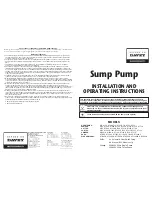
Teikoku USA | Chempump
Instruction Manual HE-10677-P (1018)
12
4.3.2 Shaft Sleeves and Thrust Collars
The rotor assembly shaft sleeves and thrust surfaces should also
be visually inspected at the bearing contact area for general ap-
pearance and uniform wear.
Excessive undercutting, pitting, or scoring is cause for replacement.
Check the following points:
1. Corrosion
2. Contact marks and wear.
4.3.3 Rotor Assembly Inspection
The complete rotor assembly should be visually inspected for
cracks, breaks, pitting, or corrosion which might destroy the ef-
fectiveness of the hermetically sealed rotor end covers and sleeve.
Check rotor assembly shafts for straightness.
4.3.4 Stator Assembly Inspection
The complete stator assembly should be visually inspected for
cracks, breaks, pitting, or corrosion of the stator liner which
may destroy the effectiveness of the barrier. Inspect the inside
of the electrical junction box for corrosion and moisture. Teikoku
recommends performing a megger and resistance check on the
motor winding.
4.3.5 General Inspection
1. Inspect the threads on both ends of the rotor shaft to en-
sure they are not damaged. Teikoku Type-R (Plan 13-SE) have
right-hand threads, except the rear rotor bolt which has left-
hand threads.
2. Be sure that all mating faces are free of nicks and burrs so that
they will have a smooth face ensuring a good seal. Clean off
any trace of old gasket material.
3. Make sure all parts are clean. Inaccessible area may be cleaned
with a small brush or pointed tool.
4. The impeller, casing, and front bearing housing should be in-
spected for wear. If excessive grooving or scoring of the rings
areas, hubs, and bores is evident, these components must be
repaired or replaced.
5. On the rear bearing housing, inspect the ports for reverse cir-
culation line to ensure that the ports are clear and free of
obstructions.
4.4 Reassembly
1. Clean and dry all parts. Reassemble in the reverse manner of
disassembly.
2. Install adjusting washer(s) into rear bearing housing. Quantity
and thickness of adjusting washers is as required for proper
rotor end play.
Attention!
The front bearing has only spiral grooves, the rear
bearing has spiral and straight grooves.
3. Insert bearing with flat washer into front and rear bearing
housings. Position flat washer side of bearing in line with set
screw hole. While holding bearing down, tighten set screw.
Caution!
Do not over-tighten set screw as damage to bearing
may occur.
4. Install anti-rotation pin/key. Slide on rear thrust collar, verify-
ing that the thrust collar is installed correctly. The coated side
of the thrust collar should be positioned facing outboard with
the chamfer side facing inboard. Slide on the rear shaft sleeve,
ensuring that the shaft sleeve is tight against the thrust collar
and is engaged in the anti-rotational key or pin. Install the
flat washer, lock washer, and lock bolt, ensuring that the lock
washer tab is engaged in the slot in the shaft sleeve. Torque
lock bolt per
. This bolt has left hand threads. Bend
up tabs on lock washer.
5. Install anti-rotation pin/key. Slide on front thrust collar, veri-
fying that the thrust collar is installed correctly. The coated
side of the thrust collar should be positioned facing outboard
with the chamfer side facing inboard. Slide on the front shaft
sleeve ensuring that the shaft sleeve is tight against the thrust
collar and is engaged in the anti-rotational key or pin. Slide
assembled rotor into stator with rear end of rotor extending
out of the stator.
6. Install the rear stator gasket. Slide the rear bearing housing
onto the rotor and slide the rear bearing housing and rotor
into the stator. Take care to tighten bolting evenly using a star
or cross pattern. Torque bolts per
7. Slide front bearing housing onto rotor and into stator. Take
care to tighten bolting evenly. Ensure that the shaft sleeve
is tight against the thrust collar and is engaged in the anti-
rotational key or pin. Verify that the rotating assembly rotates
freely by hand with no binding or rubs.
8. Install adjusting washers onto rotor shaft. Quantity and thick-
ness is as required for proper “g”gap.
9. Install impeller key.
10. Slide impeller and inducer, if required, onto rotor shaft, install
the flat washer, lock washer and lock bolt ensuring that the
lock washer tab is engaged in the impeller key slot. Check
rotor assembly end play. End play should be within the range
indicated in
. If the rotor assembly does not fall
within this range, remove rear bearing housing, remove rear
bearing and increase or decrease the adjusting washer quan-
titiy and thickness as required.
11. Measure the “g”gap by pulling impeller forward shown in
. The “g”gap should be within indicated ranges
shown in
. If gap is not within specified range, use
adjusting washers behind impeller to make adjustments.
12. Make sure impeller bolt is tight (see
for correct
torque values) and lock washer locking tabs are bent over.
13. Assembled pump should rotate freely by hand with no metal
to metal contact.













































